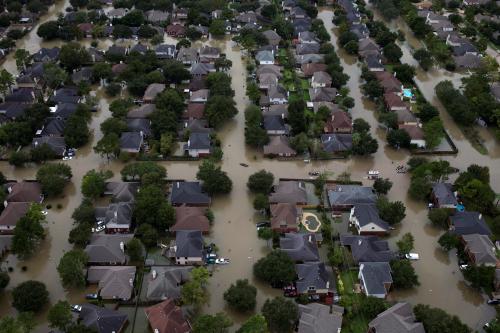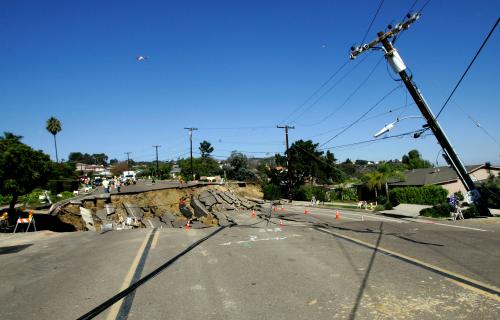This piece originally appeared in Governing
In the aftermath of catastrophes like Harvey and Irma, reliable, transparent information can guide a democratic and inclusive rebuilding effort.
As Hurricane Irma slams into Florida and Texans begin to recover after Hurricane Harvey, the question looms: How do major urban centers and small communities rebuild after a catastrophic natural disaster?
To recover from a disaster on the scale of Harvey and Irma requires a massive coordinated effort. Federal, state and local governments must lead. Philanthropy, nonprofits and the private sector will be key partners. Residents will voice their views, through community planning meetings and other venues, on how best to spend disaster-recovery dollars. With so many stakeholders and rebuilding needs, the process of restoring neighborhoods and economic activity will become emotionally and politically charged. As Brock Long, administrator of the Federal Emergency Management Agency, has already warned in Texas: “This is going to be a frustrating and painful process.”
For public officials to effectively steer a recovery process and for citizens to trust in the effort, reliable, transparent information will be essential. Leaders and the public need a shared understanding of the scale and extent of the damage and which households, businesses and neighborhoods have been affected. This is not a one-time effort. Data must be collected and issued regularly over months and years to match the duration of the rebuilding effort.
Without this information, it will be nearly impossible to estimate the nature of aid required, determine how best to deploy resources, prioritize spending and monitor progress. Rebuilding processes are chaotic, with emotions high over multiple, competing priorities. Credible public information organized in one place can help to neutralize misconceptions, put every need in context and depoliticize decision-making. Most importantly, data on recovery needs also can enable citizen involvement and allow residents to hold public leaders accountable for progress.
We know this first-hand from our experience in New Orleans, where the Brookings Institution and the New Orleans Data Center teamed up to produce what became the New Orleans Index following Hurricane Katrina in 2005. We set out to help the public and decision-makers understand the level of outstanding damage in New Orleans and the region and to monitor the extent to which the city was bouncing back.
To be as real-time as possible, we assembled data from federal and local agencies, industry and association groups. We were able to provide regular estimates on the extent to which residents were returning to the city, the pace of housing reconstruction and the level of available infrastructure and essential services such as electricity, schools and hospitals. To track the economic recovery, we measured new business openings and the health of key industries. As the recovery evolved, we added new measures, such as mapping progress by neighborhood to ensure that no communities were neglected.
This public information yielded essential findings. In the immediate months after Katrina, for example, mortgage delinquency rates spiked as personal incomes dropped. The number of homes for sale escalated as some households chose not to rebuild. Meanwhile, other homeowners with means and insurance were the first to renovate, followed by those who needed federal assistance. Repairs of rental units were slower, temporarily raising area rents and slowing the recovery of several industries dependent on lower-wage employees. Infrastructure rebuilding lagged most of all: Five months after the storm, the few open public schools had a waiting list of children trying to enroll. Even three years after Katrina, police stations still operated out of FEMA trailers and temporary buildings. And the levees protecting New Orleans were not substantially rebuilt until six years after the massive flooding.
This kind of transparent data informed action. The White House and federal and state agencies used it to shape the design of housing-assistance programs and to better understand which aspects of the recovery needed more attention. Monthly and quarterly updates put pressure on government agencies to get dollars on the streets faster, with greater flexibility to match local needs. State leaders used the data to make the case for additional supplemental federal funding for home and infrastructure repairs. The information empowered nonprofits and neighborhood advocates as they emphasized the need for more rental housing. And this public data resource helped spur private investment by measuring signs of economic vitality in key sectors and neighborhoods.
In the wake of Harvey and Irma, high-quality, regular and public information will be critical to a democratic and inclusive rebuilding effort. As recovery dollars are channeled through federal, state and local intermediaries to people and neighborhoods across the region, a public resource along the lines of the New Orleans Index would help empower local groups and ensure informed, rational debate and decision-making. Given advances in technology and data availability in the decade since Katrina, creating such a resource is more feasible than ever.
While Houston and New Orleans face different sets of challenges after their catastrophic disasters, as will Florida, one lesson from New Orleans is clear: democratized information will be critical to the rebuilding process.







Commentary
Op-edDisaster recovery’s essential tool: Data
September 20, 2017